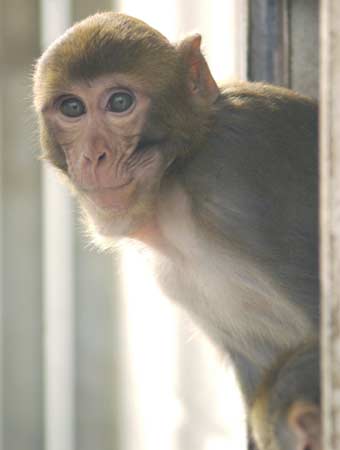Anxious Monkeys Shed Light on Human Temperament

Researchers have discovered particular brain regions are associated with developing childhood anxiety. The finding may lead to new strategies for early detection and treatment of at-risk children.
"Children with anxious temperaments suffer from extreme shyness, persistent worry and increased bodily responses to stress," says Ned H. Kalin, chair of psychiatry at the University of Wisconsin-Madison School of Medicine and Public Health.
"It has long been known that these children are at increased risk of developing anxiety, depression, and associated substance abuse disorders."
The new study by Kalin and colleagues demonstrated that increased brain activity in the amygdala and anterior hippocampus could predict anxious temperament in young primates.
"We believe that young children who have higher activity in these brain regions are more likely to develop anxiety and depression as adolescents and adults and are also more likely to develop drug and alcohol problems in an attempt to treat their distress," says Kalin.
The study is published in the journal Nature.
Previous research led by Kalin established that anxious young monkeys are similar to children who are temperamentally anxious. In the current study, researchers examined the extent to which genetic and environmental factors influence activity in the anxiety-related brain regions that may make children vulnerable.
Sign up for the Live Science daily newsletter now
Get the world’s most fascinating discoveries delivered straight to your inbox.
In the largest imaging study of nonhuman primates, the researchers at UW-Madison scanned the brains of 238 young rhesus monkeys, all of which belong to the same extended family. The monkeys underwent a positron emission tomography (PET) scan, which in humans is used to understand regional brain function by measuring the brain’s use of glucose.
Key findings of the study include:
- Young rhesus monkeys from a large, related family showed a clear pattern of inherited anxious temperament.
- Monkeys with anxious temperaments had higher activity in the central nucleus of the amygdala and the anterior hippocampus. In addition, researchers could predict an individual’s degree of anxious temperament by its brain activity.
- Genes and environmental factors affected activity in the amygdala and hippocampus in different ways, providing a brain-based understanding of how nature and nurture might interact to determine an individual’s vulnerability to developing common psychiatric disorders.
First author Jonathan Oler, associate scientist at the UW-Madison Department of Psychiatry, says the findings were a surprise.
"We expected that all of the brain regions involved in anxious temperament would be similarly affected by genes and environment, but found that activity in the anterior hippocampus was more heritable than in the amygdala," says Oler.
The new discovery may ultimately lead to new ways to detect anxiety in children, says Drew Fox, a graduate student working with Kalin and a co-author on the study.
"Markers of familial risk for anxiety could be identified by understanding alterations in specific genes that influence hippocampal function," says Fox.
The study suggests that there is a tremendous opportunity to modify the environment to prevent children from developing full-blown anxiety.
"My feeling is that the earlier we intervene with children, the more likely they will be to lead a happy life in which they aren’t as controlled by anxiety and depression," says Kalin, who is also director of the UW-Madison HealthEmotions Research Institute.
"We think we can train vulnerable kids to settle their brains down."
- 10 Things You Didn't Know About You
- Understanding the 10 Most Destructive Human Behaviors
- Prevent Anxiety Disorders in Children









